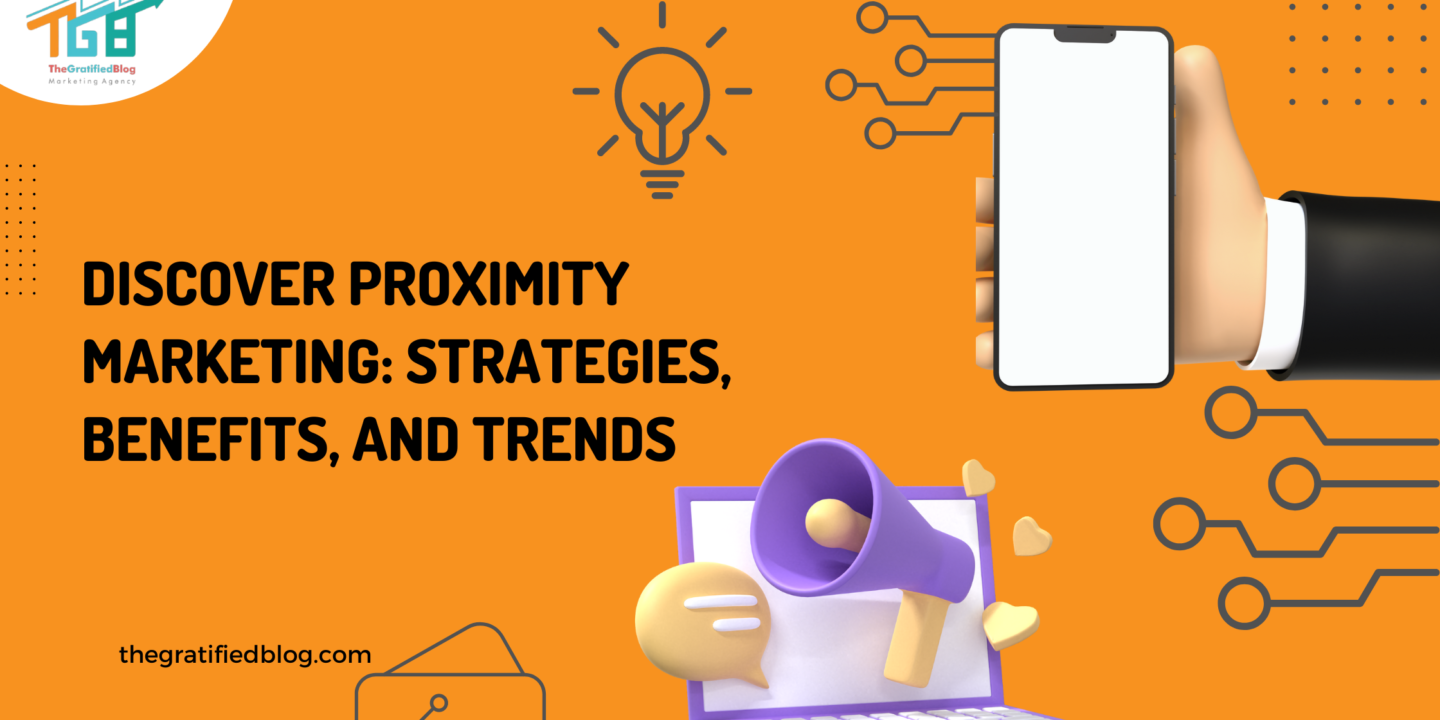
In today’s digitally connected world, where personalized experiences reign supreme, proximity marketing has emerged as a significant shift for businesses aiming to connect with their customers meaningfully.
Proximity marketing revolves around leveraging location-based technologies to deliver targeted messages and promotions to individuals physically close to a business or a specific location.
This blog explores the fascinating realm of proximity marketing, delving into its key technologies, benefits, future trends, and faqs. Come along as we explore how proximity marketing transforms modern marketing, boosts customer engagement, and elevates brand experiences to new heights.
So, let’s get started:
What Is Proximity Marketing?
Proximity marketing refers to delivering targeted marketing messages, promotions, and content to individuals based on their proximity to a specific location or business.
Benefits Of Proximity Marketing
- Enhanced Customer Engagement: Proximity marketing enables businesses to create highly personalized customer experiences. By leveraging location-based technologies like beacons or geofencing, companies can deliver relevant and timely messages, offers, and content to individuals based on their real-time location. For example, a retail store could send a customized discount voucher to a customer’s smartphone when they enter the store, enticing them to purchase. This level of personalization not only enhances customer engagement but also nurtures a stronger bond between the brand and the consumer.
- Increased Foot Traffic and Sales Conversion Rates: It can drive foot traffic to real-world places like retail stores, restaurants, or event venues. By sending targeted promotions and incentives to customers when they are nearby, businesses can encourage them to visit the store or venue, leading to increased foot traffic. Moreover, proximity marketing campaigns have been shown to have higher conversion rates as they target customers who are already nearby and more likely to purchase or engage with the brand.
- Data-Driven Insights: Proximity marketing gives businesses valuable data insights into customer behavior and preferences. By analyzing data collected from location-based interactions, companies can better understand terms such as popular visiting times, dwell times, and preferred areas within a store or venue. This information can be used to customize marketing strategies, enhance customer experiences, and streamline business operations. For example, a museum can analyze visitor heatmaps generated through proximity marketing to determine the most popular exhibits and adjust exhibit placement or marketing efforts accordingly.
- Cost-Effectiveness Compared to Traditional Marketing Channels: Proximity Marketing frequently offers greater cost-efficiency than traditional channels like print advertising or TV commercials. It allows businesses to precisely target specific audiences, reducing spending on broad, mass-market campaigns. Additionally, proximity marketing campaigns can be automated and optimized based on real-time data, maximizing ROI and efficiency. For small businesses with limited marketing budgets, Proximity Marketing provides an economical method to reach and captivate customers in their local area, driving results without breaking the bank.
Now that you understand proximity marketing and its advantages let’s delve into the key technologies and tools it utilizes.
Key Technologies And Tools In Proximity Marketing

Beacon Technology
- Explanation: Beacons are small, Bluetooth-enabled devices placed in physical locations like stores, museums, or events. They release signals that can be picked up by smartphones or tablets nearby.
- Use Cases: Beacons send personalized messages, offers, or information to users’ devices when they enter the beacon’s range. For instance, a retail store can transmit a welcome message or a discount coupon to a customer’s phone when they enter the store.
Near Field Communication (NFC)
- Explanation: NFC is a short-range wireless technology that enables communication between devices nearby (typically a few centimeters).
- Complements Proximity Marketing: NFC complements proximity marketing by allowing devices to interact quickly and securely without internet connectivity. For instance, NFC tags can be used in marketing materials like posters or product displays to deliver instant information or promotions to users’ NFC-enabled devices.
Bluetooth Low Energy (BLE)
- Explanation: BLE is a power-efficient version of Bluetooth Technology that enables devices to communicate within proximity with minimal energy consumption.
- Role in Proximity-Based Advertising: BLE is commonly used in proximity marketing to establish connections between beacons and users’ devices. It enables beacon devices to transmit signals efficiently, extending battery life and enhancing the reliability of proximity-based advertising campaigns.
Geofencing
- Definition: Geofencing is a location-based technology that creates virtual boun
diaries or “geofences” around physical areas or locations.
- Examples: In marketing, geofencing triggers notifications, ads, or offers when users enter or exit a defined geofenced area. For instance, a restaurant can send a special discount message to users’ phones when they are near the restaurant’s location, prompting them to visit and avail of the offer.
Now, let’s explore the upcoming trends in this field
Future Trends And Innovations In Proximity Marketing
AI-driven Proximity Marketing:
AI-driven proximity marketing involves leveraging predictive analytics, which use machine learning algorithms to deliver highly personalized and contextually relevant user experiences. Predictive analytics analyze historical data to anticipate customer behavior and preferences, allowing businesses to proactively tailor marketing messages and offers.
Machine learning algorithms continuously learn from user interactions and feedback, enabling dynamic adjustments and optimization of marketing campaigns in real-time. This approach enhances customer engagement, improves campaign effectiveness, and drives better ROI by delivering the right message to the right person at the right time.
Integration with IoT Devices:
Integrating proximity marketing with IoT devices enhances customer experiences by creating seamless and interconnected environments. IoT devices such as intelligent beacons, wearables, and connected appliances enable precise location tracking and interaction capabilities.
For example, intelligent beacons can communicate with wearable devices to provide personalized notifications or recommendations based on user preferences and proximity. This integration also enables businesses to gather richer data insights and automate personalized interactions across various touchpoints, contributing to a more immersive and engaging customer journey.
Applications of Augmented Reality (AR) and Virtual Reality (VR) in Proximity Marketing:
AR and VR applications in proximity marketing add a new dimension to customer engagement by offering immersive and interactive experiences. AR integrates digital content into the physical environment, enabling users to interact with virtual elements in real-time through mobile devices. For instance, AR can be used in retail stores to provide virtual try-on experiences for products or to display interactive product information when users scan specific items. Conversely, VR creates virtual environments where users can explore and interact, offering unique storytelling and brand experiences. By integrating AR and VR technologies into proximity marketing strategies, businesses can capture attention, drive engagement, and differentiate their brand in a competitive landscape.
FAQs
Q1. What is proximity marketing?
A. Proximity marketing uses location-based technologies like beacons, NFC, and geofencing to deliver targeted messages, promotions, and content to individuals based on their proximity to a business or location.
Q2. What are the key technologies used in proximity marketing?
A. Beacons, near-field Communication (NFC), Bluetooth Low Energy (BLE), and geofencing are critical technologies used in proximity marketing.
Q3. What are the benefits of proximity marketing?
A. The benefits of proximity marketing include enhanced customer engagement, increased foot traffic and sales conversions, data-driven insights into customer behavior, and cost-effectiveness compared to traditional marketing channels.
Conclusion
After learning about proximity marketing, it’s clear that it’s an excellent way for businesses to connect with customers by personalizing messages based on where they are. As companies adjust to the digital world, proximity marketing can help them stand out by giving customers experiences that match their interests and location. Embracing these new ideas can make marketing more effective, helping businesses grow and retain customers in a competitive market.
However, if you still have any questions related to the blog, please feel free to leave them in the comment section below. We will be happy to answer them.
Thanks for reading 🙂








No Comments